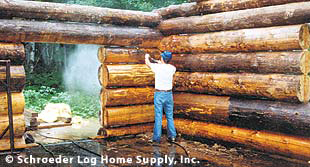 At the risk of sounding sappy, I am going out on a limb to offer without apology another sentimental perspective of log homes.
At the risk of sounding sappy, I am going out on a limb to offer without apology another sentimental perspective of log homes.As the New Year approaches and I look at photos I've taken of historic log buildings, I am touched by the significance log homes have regarding time and encapsulated stories- not only the cabins themselves, but also the individual logs they are made of.
Log cabins, whether newly built or 200 years old, have a nostalgia that brings us back to simpler times. Every log building has its story- be it a new log home that is the realization of a couple's dream or a small log cabin that has watched the passing of decades and centuries. Every log building has its story, but every log within that building also has its tale. The log home might be settling-and-shrinking new, or it might be 200 years old, but whatever the life of the home is, the logs are likely 50-200 years older. Take a moment to look at the logs in your home. Each ring represents a year in that tree's life, each knot is a limb that it had. Each ridge of texture was the stroke of a drawknife, axe or adze, and each notch was carefully scribed, cut and perfected by a skilled craftsman. Even on a milled log home, the surface of the log was at one point passed over by a blade and inspected by a wood professional.
 If the home has a stone fireplace or masonry accents, there's a whole new pile of stories. The stones have a history thousands of years older and a story possibly even more impressive than the logs. Those rocks were once molten lava, then broken up by the movement of glaciers, thousands of years later selected and split by a mason, and finally fit precisely into the final, artistic monument.
If the home has a stone fireplace or masonry accents, there's a whole new pile of stories. The stones have a history thousands of years older and a story possibly even more impressive than the logs. Those rocks were once molten lava, then broken up by the movement of glaciers, thousands of years later selected and split by a mason, and finally fit precisely into the final, artistic monument.Next time you are passing some time enjoying your log home, or next time you walk into an historic log cabin, take a moment to ponder the life of the logs and the life of the structure and appreciate all that a log home is. Look at the logs and think about how each started as a seedling. Each grew large and provided food and shelter for countless birds and animals. Each knot on that log was once a limb that may have held an eagle or a porcupine. At some point, someone- a lonely pioneer or a modern logger -came along, selected that tree, and cut it down. The limbs were removed, the bark was peeled, the logs were cut. Each log was cut, measured and scribed to fit in the structure and nestle on top of the log below it. Once sweat and strain erected the building, an individual, a couple, or a family moved in and called it home. A log home is the perfect intersection of natural occurrences and human productivity; the place where the concentric, chronological ripples of trees and people intersect. A log home is not just a building; it is a cozy testimony of time.
From the quaint birthplace of Abraham Lincoln, to the impressive Old Faithful Inn, there are hundreds of log buildings scattered around the country that are rich with stories they've acquired through time. The story of each building is extended even farther into time with the story of each tree and rock that was used to build it; from pioneers erecting a quick log cabin shelter to engineers carefully planning a massive, log tourist destination. Take some time to look at your log home or the log cabins around you. How many years have they seen pass? What is their story?
First photo is the log cabin at Traverse des Sioux historical site in Saint Peter, MN, before its restoration.
Second photo is the fireplace at the Chippewa National Forest Supervisor's Office in Cass Lake, MN.







